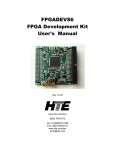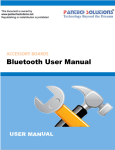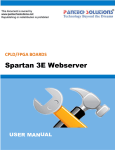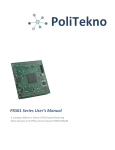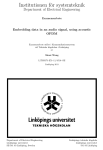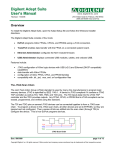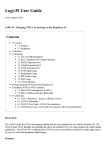Download Spartan 6 Tyro Kit - Pantech Solutions
Transcript
CPLD/FPGA BOARDS Spartan 6 Tyro Kit Join the Technical Community Today! http://www.pantechsolutions.net Contents Introduction: .................................................................................................................. 4 The board features: .................................................................................................... 4 External Peripherals Modules ..................................................................................... 4 Communication protocols........................................................................................... 4 Other Features:........................................................................................................... 5 Technical or Customer Support................................................................................... 5 1. Using Spartan-6 Tyro Kit .......................................................................................... 5 1.1 Package Contents .............................................................................................. 5 2. Learning Spartan-6 Tyro kit ...................................................................................... 6 2.1 Components placement .................................................................................... 7 2.2 Block Diagram.................................................................................................... 8 2.3 Power Distribution............................................................................................. 8 2.3.1 AC Wall Adapter .......................................................................................... 8 2.4 On-board Peripherals ...................................................................................... 10 2.5 Digital Inputs Toggle Switch ............................................................................. 11 2.6 Light Emitting Diodes ....................................................................................... 13 2.7 Character 2 x 16 LCD ........................................................................................ 15 2.7.1 Voltage Compatibility ................................................................................ 16 2.8 128 x 64 GLCD.................................................................................................. 17 2.9 Relay Section ................................................................................................... 19 2.10 RS-232 Serial Port ............................................................................................ 21 2.11 12 Bit ADC........................................................................................................ 22 SPI TRANSFER ........................................................................................................... 24 12 Bit SPI DAC ........................................................................................................ 24 Join the Technical Community Today! http://www.pantechsolutions.net 2.12 Push Button and Reset switch ......................................................................... 26 2.13 Clock Source .................................................................................................... 27 2.14 Expansion I/O Connectors ............................................................................... 28 2.15 Spartan-6 FPGA ............................................................................................... 30 2.16 Configuration PROM ........................................................................................ 32 JTAG Programming/Debugging Ports ........................................................................ 34 Join the Technical Community Today! http://www.pantechsolutions.net Introduction: The board features: Xilinx Spartan 6 (XC6SLX9-TQG144) FPGA Xilinx Serial PROM (XCF04S) External Peripherals Modules 128x64 G LCD with Contrast adjusts 16-Nos. General purpose point LEDs 16-Nos of Toggle switches (Digital inputs) 2-Nos. of Push Button 1-Nos. of Piezo Electric Buzzer 5V Relay with termination Communication protocols Two Full Duplex UART (EIA RS232) Join the Technical Community Today! http://www.pantechsolutions.net SPI ADC and DAC interface Other Features: 50 MHz crystal oscillator clock source Hard Reset Push Button Technical or Customer Support Post your questions: Pantech forum: www.pantechsolution.net/forum Web site: www.pantechsolutions.net 1. Using Spartan-6 Tyro Kit 1.1 Package Contents Spartan-6 Tyro Kit Serial Port Cable Join the Technical Community Today! http://www.pantechsolutions.net JTAG Download Cable Printed User Manual 9V Power AC Adaptor LCD module (optional) GLCD module (optional) CD contains o Software o Example Programs o User Manual o Simple Projects 2. Learning Spartan-6 Tyro kit The Spartan-6 Board comes with Xilinx Spartan-6(XC6SLX9) FPGA. It consist of several peripherals, power supply and supporting device circuitry systems. Spartan-6 Board provides a basic development platform for the FPGA device with all I/O available to the user. The device may be programmed in-circuit through the JTAG port from the PC. We meet all the basic specifications’ standards with this product. One can experience the ease in the experimentation of Xilinx FPGA with many of the external peripherals. Join the Technical Community Today! http://www.pantechsolutions.net 2.1 Components placement Figure 1.Spartan-6 Tyro Kit Components placement Join the Technical Community Today! http://www.pantechsolutions.net 2.2 Block Diagram Figure 2 Spartan-6 Tyro Kit Block Diagram 2.3 Power Distribution 2.3.1AC Wall Adapter Join the Technical Community Today! http://www.pantechsolutions.net The Spartan-6 Tyro Kit includes an AC wall adapter that produces a +9V DC output. Connect the AC wall adapter to the barrel connector along the left edge of the board, indicated as in Error! Reference source not found.. To disconnect power, switch off the power switch. The power indicator LED, lights up when power is properly applied to the board. The AC wall adapter operates from 100V to 240V AC input, at 50 or 60 Hz. Voltage Regulators There are multiple voltages supplied on the Spartan-6 Tyro Kit Lab Kit: 5V, 3.3V and 1.2V regulators. The 3.3V regulator feeds all the VCCO voltage supply inputs to the FPGA’s I/O banks and powers most of the components on the board. The 3.3V regulator supplies power to the FPGA’s VCCAUX supply inputs. The VCCAUX voltage input supplies power to Digital Clock Managers (DCMs) within the FPGA and supplies some of the I/O structures. In specific, all of the FPGA’s dedicated configuration pins, such as DONE, PROG_B, CCLK, and the FPGA’s JTAG pins, are powered by VCCAUX. The FPGA configuration interface on the board is powered by 3.3V. Consequently, the 3.3V supply has a current shunt resistor to prevent reverse current. Finally, the 1.2V regulator supplies power to the FPGA’s VCCINT voltage inputs, which power the FPGA’s core logic. The board uses four discrete regulators to generate the necessary voltages. The 5V Regulator supplies power for Stepper Motor, DC Motor, Relays, GLCD and LCD. Join the Technical Community Today! http://www.pantechsolutions.net 2.4 On-board Peripherals The Spartan-6 Tyro Kit comes with many interfacing options 2 Nos. of Push Button 16-Nos. of Toggle switches (Digital Inputs) 16-Nos. of Point LED’s (Digital Outputs) 2x16 Character LCD 128x64 G LCD with Contrast adjusts 5V Relay Two UART for serial port communication through PC Join the Technical Community Today! http://www.pantechsolutions.net Piezo Electric Buzzer SPI ADC SPI DAC Reset switch 2.5 Digital Inputs Toggle Switch The Spartan-6 Tyro Kit has 16-slide switches, indicated as in Figure 44. The switches connect to an associated pin name, as shown in Table 1. A detailed schematic appears in Figure 4. Join the Technical Community Today! http://www.pantechsolutions.net Join the Technical Community Today! http://www.pantechsolutions.net Table 1. Pin Connections to Slide Switches SWITCH Pin Name SWITCH Pin Name Sw2 Sw3 Sw4 Sw5 Sw6 Sw7 Sw8 Sw9 P57 P56 P55 P51 P50 P48 P47 P46 Sw10 Sw11 Sw12 Sw13 Sw14 Sw15 Sw16 Sw17 P33 P32 P30 P29 P27 P26 P24 P23 When in the UP or ON position, a switch connects logic High. When DOWN or in the OFF position, the switch connects to ground, a logic Low. The switches typically exhibit about 2 ms of mechanical bounce and there is no active debouncing circuitry, although such circuitry could easily be added to the FPGA design programmed on the board. A 10KΩ series resistor provides nominal input protection. Example Code To see the demo result, click inside Digital Input Switch folder of the CD. 2.6 Light Emitting Diodes Join the Technical Community Today! http://www.pantechsolutions.net Light Emitting Diodes (LEDs) are the most commonly used components, usually for displaying pin’s digital states. The Spartan-6 Tyro Kit has 16- LEDs located above the slide switches, indicated by in Figure5. Figure 5.Point LED interface from Spartan-6 Tyro Kit Table 2.Pin connections to the LEDs Join the Technical Community Today! http://www.pantechsolutions.net ED L 2 Pin 74 Name ED L 10 Pin 45 Name D D D D D D D D 3 4 5 6 7 8 9 P 67 P 66 P 64 P 62 P 61 P 59 P 58 P D 11 D 12 D 13 D 14 D 15 D 16 D 17 D P 44 P 43 P 41 P 40 P 38 P 35 P 34 P The cathode of each LED connects to ground via a 220 ohm Ω resistor. To light an individual LED, drive the associated FPGA control signal High, which is the opposite polarity from lighting one of the 7-segment LEDs. Example Code To see the demo result, click inside LED folder of the CD. 2.7 Character 2 x 16 LCD The Spartan-6 Tyro Kit prominently features a 2-line by 16character liquid crystal display (LCD). The Top board controls the LCD via Join the Technical Community Today! http://www.pantechsolutions.net the 8-bit data interface shown in Figure. Although the LCD supports an 8-bit data interface.. 2.7.1Voltage Compatibility The character LCD is power by +5V. The FPGA I/O signals are powered by 3.3V. However, the FPGA’s output levels are recognized as valid Low or High logic levels by the LCD. The LCD controller accepts 5V TTL signal levels and the 3.3V LVCMOS outputs provided by the FPGA to meet the 5V TTL voltage level requirements. The character LCD drives the data lines when LCD_RW is high. Most applications treat the LCD as a write-only peripheral and never read from the display. Table 3.Pin Connection to LCD Interface Signal PIN Name R/W P10 RS P8 E P9 D0 P22 D1 P21 D2 P17 D3 P16 D4 P15 Join the Technical Community Today! http://www.pantechsolutions.net D5 P14 D6 P12 D7 P11 Figure 7.LCD connections from Spartan-6 Tyro Kit Example Code To see the demo result, click inside LCD folder of the CD. 2.8 128 x 64 GLCD Join the Technical Community Today! http://www.pantechsolutions.net The Spartan-6 Tyro Kit has 128x64 GLCD. 14 pins are needed to create 8-bit interface; 8 data bits (DB0-DB7), two chip select line (CS1) and (CS2), address bit (R/S), read/write bit (R/W) and control signal (E) and Reset (RST). The GLCD controller is a standard S6B0108 or equivalent, which is a very well-known interface for Graphical based LCDs. Figure 8.GLCD connections from Spartan-6 Tyro Kit Table 4.Pin Connection to GLCD Interface Join the Technical Community Today! http://www.pantechsolutions.net Signal PIN Name R/W P10 RS P8 E P9 D0 P22 D1 P21 D2 P17 D3 P16 D4 P15 D5 P14 D6 P12 D7 P11 CS1 P7 CS2 P6 Example Code To see the demo result, click inside GLCD folder of the CD. 2.9 Relay Section In Spartan-6 Tyro Kit , SPDT relay is used. TThe relays operate on 5V DC. The outputs of both the terminals of the relay are taken out on the connecter to connect the external circuitry. Join the Technical Community Today! http://www.pantechsolutions.net Figure 9.Schematic showing the relay connections Table 5.Pin Connections to Relay/Driver Signals PIN NAME Relay P78 Example Code To see the demo result, click inside Relay Control folder of the CD. Join the Technical Community Today! http://www.pantechsolutions.net 2.10 RS-232 Serial Port USART stands for Universal Synchronous Asynchronous Receiver Transmitter. Spartan-6 Tyro Kit supports both types of communication. The Spartan-6 Tyro Kit provides an RS232 port that can be driven by the top board FPGA. A subset of the RS232 signals is used on the Kit to implement this interface (RD and TD signals). The Spartan-6 Tyro Kit provides 2- female connector DB-9 connector, labeled P1 and P2. This board utilizes the Maxim Instruments MAX3232 RS232 driver for driving the RD and TD signals. Table 6. RS232 signals and their pin assignments to the Spartan-3 FPGA Connector Signals Name FPGA PIN P1 TXD0 P84 RXD0 P83 TXD1 P82 RXD1 P81 P2 Join the Technical Community Today! http://www.pantechsolutions.net Figure 10.Detailed schematic of Spartan-6 Tyro Kit Interface with RS232 Example Code To see the demo result, click inside RS232 folder of the CD. 2.11 12 Bit ADC These ADCs are SPI Bus based which is a serial bus. So the number of pins in IC is very low. Total of 4 lines are required to interface it with FPGA. Join the Technical Community Today! http://www.pantechsolutions.net MISO (Master In Slave Out) MOSI (Master Out Slave In) SCK (Serial Clock) CS (Chip Select) Figure 11.SPI ADC Pin Diagram Table 7. ADC Pin Connection with Spartan-6 Tyro Kit Co nn e ct or N a m e Si gn a l s CHANNEL 0 MCP3202 FP G A PI N D P93 DI P92 SC P88 CS P87 OUT SPARTAN6 CHANNEL 1 N K Join the Technical Community Today! http://www.pantechsolutions.net As you know in synchronous serial communication their is a clock line (SCK in case of SPI) which synchronizes the transfer. The clock is always controlled by the MASTER. In our case the Spartan-6 is the MASTER and the MCP3202 is a slave on the bus. SPI is full duplex, which means data can be sent and received simultaneously. SPI TRANSFER A SPI transfer is initiated by the MASTER pulling the CS line low. The CS line sits at HIGH during idle state. Now master can write to the bus in 8bit (or 1 byte) chunks. One most important thing to note about SPI is that for every byte MASTER writes to SLAVE the MASTER receives one byte in return. So the only transaction possible is exchange of data. Their is no separate Read and Write commands their is only one command and that is Write. Example Code To see the demo result, click inside ADC folder of the CD. 12 Bit SPI DAC The controller designed coverts the digital data into analog, where the digital data is transferred using SPI Controller and DAC (MCP4921) converts the serial data into the analog. SPI Controller controls Join the Technical Community Today! http://www.pantechsolutions.net the speed, data transmission, DAC selection etc. Based on the inputs from the SPI line, DAC (MCP4921) coverts the 12 bit data to analog. Figure 12.SPI DAC Pin Diagram Table 8. DAC Pin Connection with Spartan-6 Tyro Kit Co nn e ct or N a m e Si gn a l s FP G A PI N P97 DAC SELECTION CS SC K MCP4921 P95 P94 SPARTAN6 SDI ANALOG O/P Example Code To see the demo result, click inside DAC folder of the CD. Join the Technical Community Today! http://www.pantechsolutions.net 2.12 Push Button and Reset switch It consist of two Push Buttons. It can be used to make an interrupt during application running. Reset switch forces the FPGA to reconfigure from the selected configuration memory source. Press and release this button to restart the FPGA configuration process at any time. Table 9. Pin Connection with Spartan-6 Tyro Kit Signals PIN NAME PushButton1 P80 PushButton2 P79 Reset RST Figure 13.Push Button and Reset switch Interface with Spartan-6 Tyro Kit Join the Technical Community Today! http://www.pantechsolutions.net 2.13 Clock Source The Spartan-6 Tyro Kit has a dedicated 50 MHz series clock oscillator source and an optional socket for another clock oscillator source. Figure provides a detailed schematic for the clock sources. Table 10.Clock Oscillator Sources Signals PIN NAME 50MHZ P85 VCC3V3 3 OUT GND Y1 SMD smd 2 OE VDD 4 0.47uF C16 1 CLK Figure 14. Clock source connections from Spartan-6 Tyro Kit Join the Technical Community Today! http://www.pantechsolutions.net 2.14 Expansion I/O Connectors The Spartan-6 Tyro Kit consists of 20x2 pin connector and 2 no. of 10x2 pin connectors. Figure15 provides schematic for Expansion I/O connectors. Table 11.Pin name for J9 and J11 10x2 pin Expansion Connector Signals 10X2 EXP. CONNECTOR J5 PIN NAME 1 P143 2 P142 3 P141 4 P140 5 P139 6 P138 7 P137 8 P134 9 P133 10 P132 11 P131 12 P127 13 P126 14 P124 15 P123 16 P121 Join the Technical Community Today! http://www.pantechsolutions.net 17 VCC 18 GND 19 VCC 20 GND Table 12.Pin name for J6 20x2 pin Expansion Connector Signals 20X2 EXP. CONNECTOR J6 PIN NAME Signals 20X2 EXP. CONNECTOR J6 PIN NAME 1 P143 21 GND 2 P142 22 GND 3 P141 23 VCC 3V3 4 P140 24 VCC 3V3 5 P139 25 P120 6 P138 26 P119 7 P137 27 P118 8 P134 28 P117 9 P133 29 P116 10 P132 30 P115 11 P131 31 P114 12 P127 32 P112 13 P126 33 P111 Join the Technical Community Today! http://www.pantechsolutions.net 14 P124 34 P105 15 P123 35 P104 16 P121 36 P102 17 GND 37 P101 18 GND 38 P100 19 VCC 5V 39 P99 20 VCC 5V 40 P98 2.15 Spartan-6 FPGA Introduction The purpose of this FPGA is to integrate all the necessary components for using a FPGA, but without being targeted on a special application. The board provides 102 I/O pins to the user, who can use them as inputs, outputs or both. The following figure elaborates the denotation. Figure 15.Spartan-6 FPGA ordering information Join the Technical Community Today! http://www.pantechsolutions.net Device Part Marking Figure 16.Spartan-6 FPGA Device Part Marking The second important component on this board is the XCF04SPROM, in which you can store a bit-file. The FPGA can be programmed directly from the PROM or through the JTAG connection. If the PROM-Boot option is enabled, the FPGA will be programmed out of the PROM when the power is turned on. Also includes a JTAG programming and debugging chain. A general overview of the FPGA architecture is presented in the following figure. Join the Technical Community Today! http://www.pantechsolutions.net Figure 17.A general overview of the FPGA architecture 2.16 Configuration PROM The Spartan-6 Tyro Kit has an XCF04S serial configuration Flash PROM to store FPGA configuration data and potentially additional nonvolatile data, including Micro Blaze application code. Table 13.Jumper setting description: XC6SLX9 Jumper Setting Description JTAG The FPGA boots from Platform Flash. No additional data storage is available PROM The FPGA boots from Platform Flash, which is permanently enabled. The FPGA can read additional data from Platform Flash. Join the Technical Community Today! http://www.pantechsolutions.net JTAG OPTION For most applications, this is the default jumper setting. As shown in , the Platform Flash is enabled only during configuration when the FPGA’s DONE pin is Low. When the DONE pin goes high at the end of configuration, the Platform Flash is disabled and placed in low-power mode. Table 14.Jumper setting J u mp er S e tt i ng D e scr i pt i on M0 M1 MO D E 0 - J T A G Pr o gr a mm i ng 1 3 2 4 MO D E 1 - F l as h P r ogr a mm i ng 1 3 2 4 PROM READ OPTION The Spartan-6 Tyro Kit includes a 4Mbit Platform Flash configuration PROM. The XC3S400 FPGA on the board only requires slightly less than 1Mbit for configuration data. The remainder of the Platform Flash is available to store other non-volatile data, such as revision codes, serial numbers and coefficients. To allow the FPGA to read from Platform Flash Join the Technical Community Today! http://www.pantechsolutions.net after configuration, the jumper must be properly positioned as shown in Table 14. When the jumper is in this position, the Platform Flash is always enabled. JTAG Programming/Debugging Ports The Spartan-3 FPGA includes a JTAG programming and debugging chain. Additionally, there is JTAG headers for driving the JTAG signals from various supported JTAG download and debugging cables. A PANTECH JTAG3 low-cost parallel to JTAG cable is included as part of the kit and connects to the JTAG header. DB-25 parallel port connector connects to the 6-pin female header connector. The JTAG cable connects directly to the parallel port of a PC and to a standard 6-pin JTAG programming header in the kit that can program a devices that have a JTAG voltage of 1.8v or greater. Join the Technical Community Today! http://www.pantechsolutions.net Did you enjoy the read? Pantech solutions creates information packed technical documents like this one every month. And our website is a rich and trusted resource used by a vibrant online community of more than 1, 00,000 members from organization of all shapes and sizes. Join the Technical Community Today! http://www.pantechsolutions.net What do we sell? Our products range from Various Microcontroller development boards, DSP Boards, FPGA/CPLD boards, Communication Kits, Power electronics, Basic electronics, Robotics, Sensors, Electronic components and much more . Our goal is to make finding the parts and information you need easier and affordable so you can create awesome projects and training from Basic to Cutting edge technology. Join the Technical Community Today! http://www.pantechsolutions.net




































